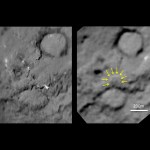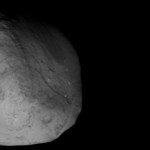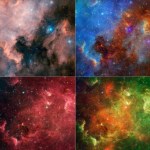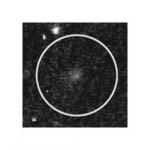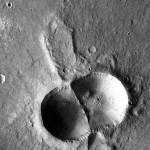Cosmos
Hat Tip The Paltry Sapien for this video by Yuanjian Luo:
A Tale of Two Twins from Yuanjian Luo on Vimeo.
On the left is the comet minding its own business. On the right is a blobish roundish area where NASA's impactor probe hit the comet.
I know, I know, it looks mainly like they just unfocused the image. It turns out that many of the images in the "after" sequence have a crappy focus, but there are enough of them here to prove that it really happened.
NASA's Stardust spacecraft returned new images of a comet showing a scar resulting from the 2005 Deep Impact mission. The images also showed the comet has a fragile and weak nucleus.
The spacecraft made its closest approach to comet Tempel 1…
NASA's Stardust-NExT mission took this image of comet Tempel 1 at 8:39 p.m. PST (11:39 p.m. EST) on Feb 14, 2011. The comet was first visited by NASA's Deep Impact mission in 2005. Image credit: NASA/JPL-Caltech/Cornell
PASADENA, Calif. -- Mission controllers at NASA's Jet Propulsion Laboratory, Pasadena, Calif., have begun receiving the first of 72 anticipated images of comet Tempel 1 taken by NASA's Stardust spacecraft.
The first six, most distant approach images are available at http://www.nasa.gov/stardust and http://www.jpl.nasa.gov. Additional images, including those from closest…
Just as I suspected. Viewed in a different light, North America vanishes. In the upper left is the North American Nebula as seen in the visible light spectrum. Obviously, it looks just like North America:
But when viewed in different parts of the spectra, it goes away. Read the story and see the pretty pictures at NASA.
And there weren't any!
No, only kidding...
NASA's NEOWISE mission has completed its survey of small bodies, asteroids and comets, in our solar system. The mission's discoveries of previously unknown objects include 20 comets, more than 33,000 asteroids in the main belt between Mars and Jupiter, and 134 near-Earth objects (NEOs). The NEOs are asteroids and comets with orbits that come within 45 million kilometers (28 million miles) of Earth's path around the sun.
Read Even More
Stardust, the NASA probe, has downloaded a snapshot of Tempel 1, a comet that the comet seeking craft will sidle up to on February 14th. Here is the picture:
On the night of encounter, the navigation camera will be used to acquire 72 high-resolution images of the comet's surface features. Stardust-NExT mission scientists will use these images to see how surface features on comet Tempel 1 have changed over the past five-and-a-half years. (Tempel 1 had previously been visited and imaged in July of 2005 by NASA's Deep Impact mission).
I don't know why they call it night. Perhaps because NASA…
A huge scar formed on Jupiter in July of 2009. It's shown here near the "bottom" of the planet:
It could have been formed by a comet like body, or by an asteroid (a rocky body).
Data from three infrared telescopes enabled scientists to observe the warm atmospheric temperatures and unique chemical conditions associated with the impact debris. By piecing together signatures of the gases and dark debris produced by the impact shockwaves, an international team of scientists was able to deduce that the object was more likely a rocky asteroid than an icy comet. Among the teams were those led by…
A question came up in the comments on the post Mars will pass behind sun, Rover operations affected, and the answer turns out to be very interesting.
The question was, to paraphrase, how often and when are the Earth based Mars rover operators out of radio contact with the Rovers? It turns out it is pretty complicated, so I'll reproduce the answer I got from Guy Webster, our man in NASA:
Opportunity (and Spirit when it's not hibernating), are out of contact most of the time every day. The rovers can communicate both directly with Earth and via relay through Mars Odyssey or Mars…
And such closeness has not been achieved before or since. Voyager 2 passed very close to the funny-named planet 25 years ago today (plus or minus) and that is the only close fly by to date.
As NASA's Voyager 2 spacecraft made the only close approach to date of our mysterious seventh planet Uranus 25 years ago, Project Scientist Ed Stone and the Voyager team gathered at NASA's Jet Propulsion Laboratory, Pasadena, Calif., to pore over the data coming in.
Images of the small, icy Uranus moon Miranda were particularly surprising. Since small moons tend to cool and freeze over rapidly after…
One of the complications of interplanetary research is that the probes you've placed on the other planet can't be reached via radio while the planet they are on passes to the other side of the sun, which happens now and then. In fact, for the days before and after Mars is opposite the sun, communication is risky because it is remotely possible that something could be misunderstood if the signal is messed up by passing near the sun. So, from January 27th through February 11th there will be no talking to the Rovers on Mars (but some listening).
Conveniently, Opportunity Rover has arrived at a…
But in a scientific way not a nasty political way. Have a look:
There are many things in this picture that are quite remarkable.
Both of these galaxies are spiral galaxies. You can see that clearly in the blue one at the bottom of the photo. The yellow one at top is as well, but you are looking at it edge on, with the main spiral being a cigar-shaped zone tilted just off the horizontal.
Perhaps these galaxies looked more similar to each other in the past, but they recently (a few hundred million years ago) ran into each other. When that happened, the yellow looking one on top in the…
No, these things are not related.
It was not that many years ago when observations were made, incidentally as I recall, of radioactivity in the upper atmosphere above large thunderstorms. I remember this being sneered at like it was a claim of cold fusion or something. Within a couple of years, however, this phenomenon was better observed and better understood, and we now know that thunderstorms sometimes produce gamma rays in the upper atmosphere. Most recently, however, something even more astonishing and amazing has been observed: These upper atmosphere high energy loci actually…
It is very hard to see cold, small, rocky planets like Earth when they are running around stars that are light years away, but Kepler found one. S, it turns out, we are not alone, at least in relation to geology.
NASA's Kepler mission confirmed the discovery of its first rocky planet, named Kepler-10b. Measuring 1.4 times the size of Earth, it is the smallest planet ever discovered outside our solar system.
The discovery of this planet, called an exoplanet, is based on more than eight months of data collected by the spacecraft from May 2009 to early January 2010.
"All of Kepler's best…
Jim Kakalios puts a very humorous spin on quantum mechanics, and while the video may be neither here nor there, the book, The Amazing Story of Quantum Mechanics: A Math-Free Exploration of the Science That Made Our World, consists of the smallest possible number of words to explain the concept in a useful and entertaining way, and thus lays an important planck in anyone's physics education.
It has been said that only three people understand quantum mechanics. Well, one of them is Jim. And, you can be the fourth!
But wait, there's more!
Jim Kakalios, Author and Professor, will appear on…
The good news: Despite their best efforts, the folks at CERN failed to produce a black hole that sucked the entire earth into it! That would have been cool. The bad news is for string theory. What might be one of the few empirical tests for that tangle of math and stuff seems to have come out negative. From CERN:
The CMS experiment at CERN's Large Hadron Collider (LHC) has completed a search for microscopic black holes produced in high-energy proton-proton collisions. No evidence for their production was found and their production has been excluded up to a black hole mass of 3.5-4.5…
NASA may have spotted evidence of ice volcanoes on Saturn's moon.
NASA's Cassini spacecraft has found possible ice volcanoes on Saturn's moon Titan that are similar in shape to those on Earth that spew molten rock.
Topography and surface composition data have enabled scientists to make the best case yet in the outer solar system for an Earth-like volcano landform that erupts in ice. The results were presented today at the American Geophysical Union meeting in San Francisco.
"When we look at our new 3-D map of Sotra Facula on Titan, we are struck by its resemblance to volcanoes like Mt. Etna…
Fast, Cheap & Out of Control is part of my own personal enigma. I have shown it to people who don't know me, who don't know what I think about, who don't know much about what I study. Nineteen out of twenty such people react in this matter:
A cold stare with underlying anger for wasting their precious time.
I admit that most of this has happened to captive audiences in the classroom, but it has also happened with family members and colleagues.
Then, time goes by. Lectures. Conversations. Blog posts. And suddenly one day, seven out of the nineteen say something like:
Oh ... Aha…
Of course, it would burn up in the process, but whatever. The following is one of those size and scale videos mainly showing the relative size of our planets and selected stars, then making quick reference to other larger scale structures. It is a good video (hat tip: Joe) but it does have a major flaw: It demonstrates that the earth is small, then it demonstrates that there are many other big structures in the galaxy, then it concludes that we are not the center of the universe. But being small does not make us NOT the center of the universe.
They've mixed up their fallacies here.…
Here's a picture:
Well, ok, actually, they didn't exactly say this in their press release, but they didn't not say it, neither, so shame on them!!! They put this picture that they KNOW imma think is mitosis and FAILED to say it wassn! FAIL I say!
But seriously, folks, the real news and as far as I know this is total, NASA-loving news-pimping hype of the kind all us science lovers love, is this: "By the middle of next week, NASA's Mars Odyssey orbiter will have worked longer at Mars than any other spacecraft in history."1
The rest of the press release is here. Even if you don't want to…
In his highly readable book, One Long Argument, Ernst Mayr breaks down the body of thought often referred to as "Darwin's Theory" into five separate and distinct theories, the second of which being "common descent." Darwin's second evolutionary theory (second by Mayr's count, not Darwin's) is really a hypothesis that could be worded this way:
All life on earth descended from a single, original, primordial form that arose eons ago.
The evidence in favor of this hypothesis is strong, but the test of the hypothesis ... the means of disproving it, which is, after all, the point of stating it to…
